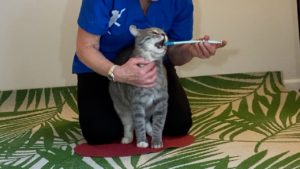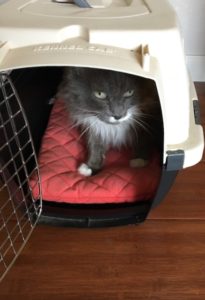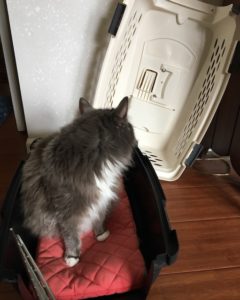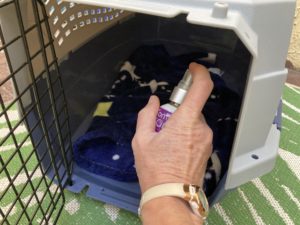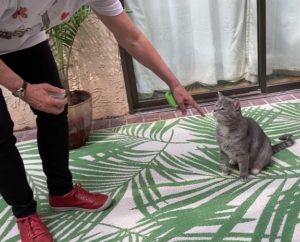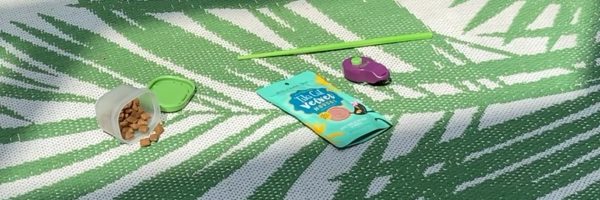Owning a cat does not mean that your arms and legs should be covered in bites and scratches. Is there anything you can do if your cat gets aggressive when playing?
First of all – understand “Play” for a cat is hunting practice and it is serious business.
Hardwired to Hunt…
Your cat is good at detecting fast motion – his eyes can process over 60 visual images per second. By comparison, we are able to process 20-30 images per second. Your cat is designed to detect the quick, rapid movements of mice and other rodents. Motion is what attracts him – if the prey “freezes” for long enough, it may get away to live another day.
A successful hunt ends with the capture of the prey. Sharp teeth and claws put an end to the game.
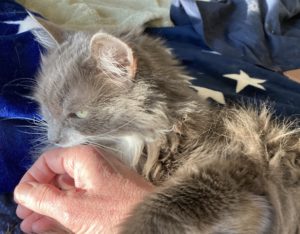
Why your cat gets aggressive when playing…
It may seem cute to let your kitten climb your legs, and pounce on your hands and feet. When your kitten grows to be a large cat, fully equipped with sharp teeth and claws, this kind of play can be dangerous.
Even if you use gloves and let your cat bite and scratch the gloves, she is still viewing YOU as PREY. After all, your arms are connected to the rest of you!
Cat bites and scratches easily become infected. Make sure to clean any bites and scratches with plenty of soap and water. Seek medical attention for bites and scratches that break the skin.
So, you feel your cat gets aggressive while playing. What can you do when he wants to play rough?
- Use toys that keep your hands and feet away from him.
- Don’t play games that have you pretending to be prey – if you want your cat to run after you, drag a string along behind you so that the string, not you, is the focus of his attention.

Zelda plays with a toy mouse on a wand toy.
What if your cat initiates “rough play”?
What is happening?
- Stalking and attacking your legs and feet?
- Wrestling and attacking your hands?
- Stalking and pouncing on you or the kids?
When does it happen?
- When you arrive home from work?
- When you are working and not able to pay attention to your cat?
Where does it happen?
- Does the behavior occur in a certain place in the house?
THE PLAN: DISTRACT YOUR CAT BEFORE THE “ROUGH PLAY” STARTS
Some examples…
Your cat attacks your legs and feet when you come in the door from work.
- Have a basket of toys on a table near the door.
- Direct her attention to a wand toy or catnip mouse BEFORE she starts to attack you.
- If your cat does manage to complete the pounce, FREEZE – don’t run away, she will “hunt” you
Your cat pounces on you when go through the hallway
- This often starts as playing “peek-a-boo” around the corner. It usually goes away on its own, but some more bored cats may make a game of it.
- Have a cache of toys nearby or some treats that you toss BEFORE you get to the corner to distract him.
- Or have a laser pointer in your pocket if this behavior happens at different corners
- If your cat does manage to complete the pounce, FREEZE. Do not reward him by acting like a prey animal trying to get away.
Your cat attacks your arm and hands while you are on the sofa watching TV
- Have a cache of toys on a table next to the sofa
- If you can intercept your cat before he launches on to the sofa, toss a treat or toy and direct him to it with a laser pointer.
- If he gets you in a “clawed” embrace, FREEZE. By not moving, he should lose interest in you.
PERSONAL PROTECTIVE EQUIPMENT
A sturdy sheet of cardboard and long pants/sleeves, socks and gloves can shield your legs, feet and hands during the “re-training” period. “Protective gear” will make staying still a bit easier.
Your cat gets aggressive when playing…Other things you can do.
Keep your cat busy and happy.
- Consider meal-feeding her with food puzzles – she can hunt for her food and not you!
- Have a regular play time around the same time every day.
- Set up a “safe place” for your cat to go when things are getting too stressful
Planning ahead – Set up a “Safe Place” for your cat
A safe place should be a place your cat feels secure
A safe place should have all her resources in it
It could be a spare room or hallway with the doors closed
Put your cat in her safe place
- when you are working
- when there is just too much going on
- when she becomes overstimulated
Your cat is a superb hunter. Make sure that he does not view you, your hands or feet as prey. Seek professional help if the simple strategies outlined here don’t work!


